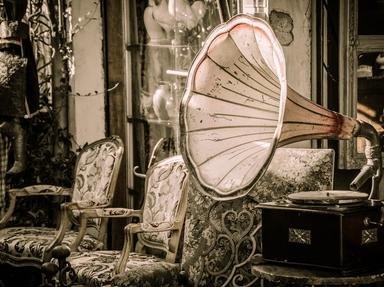Quiz Answer Key and Fun Facts
1. Every good Ancient Egyptian ensured they had all they might need for the next life entombed with them at their death. Amongst the fine kilts, scarves, tunics, socks and shirts found buried with King Tut, how many triangular cotton loincloths were discovered?
2. During the Middle Ages, men shed their loincloths, and took to wearing looser, longer, more trouser-like garments. By the 14th century, tighter-fitting hose had started to come in, but as these were often open at the crotch, something was needed to cover the, um, functional areas. Enter the ...
3. Women have always suffered for the sake of fashion. The unnaturally thin waist - so desirable in the 14th century - was initially achieved by using tightly laced cloth garments, but by the Elizabethan era (1558-1603), bodices employing rods of animal bone, or even wood, were being employed. The word 'bodice' derives from the original term used for these painful-sounding items, and was which of the following?
4. The origin of chastity belts is disputed, but they certainly existed - for both men and women - from around the 16th century. They were used as protection from assault, but were mainly designed to keep the wearer from succumbing to 'temptation'. A chastity belt said to have been worn by French Queen Consort Anne of Austria (1601-1666) is displayed in the Musée de Cluny in Paris. Rather ironically, images of which couple are etched into the belt?
5. The union suit, staple of the American Wild West, and quite possibly my favourite item of underwear ever. These garments, often made out of red or white flannel, cover a body from neck to ankle, with buttons down the front, and a buttoned panel at the rear. But why are they called union suits?
6. The origins of the brassiere, or bra, are shrouded in controversy. Several candidates as the 'mother' or 'father' of the bra come forward from the late 19th century onwards. Which of these can definitely be _discounted_ as the garment's originator in its modern form?
7. The 1930s saw the introduction to the US of men's Y-Fronts (or 'Brief Style 1001') and boxer shorts, both with elastic waistbands. However, when WWII arrived, not only rubber for waistbands, but material for the garments themselves was in short supply. Which of these was the patriotic headline on an ad, run for the Jockey brand, urging patience for men who remained at home?
8. While flashes of underwear - intentional or otherwise - have never been unusual, it took people like the flamboyant performer Madonna to really bring underwear out into the open. Her 1990 Blonde Ambition Tour saw Mads sporting a number of, um, striking corsets and bras. Which couturier was responsible for, among other things, the infamous gold lamé number which featured cups so pointed anyone close-by would fear for their eyes?
9. Hip young men were not to be outdone by the girls when it came to flashing their underwear in public. A 'fashion', made popular by hip-hop artists in the early 1990s, calls for men or boys to forsake their belts and let their jeans slide below their waists, leaving their boxers or briefs exposed. By what name is this practice known 'in da hood'?
10. What does the future hold for underwear? Research continues for incorporating all sorts of techie gizmos into knickers for purposes from the sublime - minimising ulcers and bedsores in people with mobility problems - to the ridiculous - using a 'sweatiness' sensor to control ambient room temperature. What is the generic term used for all these innovations?
Source: Author
ing
This quiz was reviewed by FunTrivia editor
bloomsby before going online.
Any errors found in FunTrivia content are routinely corrected through our feedback system.

